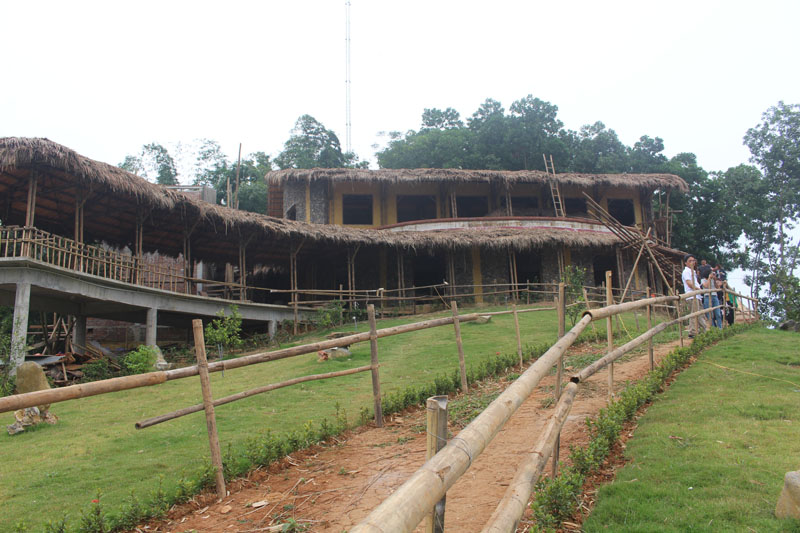
(HBO) – Mai Chau district is an outstanding tourist draw in Hoa Binh province. The provincial People’s Committee has approved a master plan to develop Mai Chau district into a national tourism site with local homestays hanging "Homestay ASEAN” award during 2016-2018. Currently, the district is focusing on calling for investments in tourism, seeing it as a spearheaded economy.
Photo:
Suoi Lon resort in Tan Mai commune (Mai Chau district) is being constructed.
Upon completion, it will serve demand of tourists inside and outside the
province.
Seeing
the significance of tourism development in Mai Chau district, the Resolution of
the 25th Congress of the provincial Party Organisation for 2015-2020
period set target of developing community-based tourism in companion with
building new-style rural areas. Particularly, in October 2016, the provincial
People’s Committee gave the green light to a master plan to develop Mai Chau
into a national tourism site by 2030. Thus, the district’s culture-sport division
has been entrusted to popularise Mai Chau’s images to attract investment.
Due attention has been given to developing workforce in tourism sector and
technical infrastructure. Currently, Mai Chau houses 146 accommodations with
seven hotels, 21 guest houses and 117 homestays. There are 13 community-based
villages with standout accommodations like Mai Chau Ecolodge resort (Na Phon
commune), Villas Mai Chau (Mai Hich commune), Lac village (Chieng Chau commune),
Pom Cong (Mai Chau town) and Hich village (Mai Hich commune).
Diverse tourism products have made Mai Chau attractive to both
domestic and foreign tourists. Revenue from tourism services, as a result,
remarkably increased, contributing to increasing state budget collection and
improving local livelihoods. Last year, the district earned over nearly 89.38
billion VND from welcoming 324,536 tourists, including 99,314 foreigners and
225,222 domestic travellers.
The district has attracted investors in various projects like Mai Chau
Ecolodge, Sol Bungalows together with branching out community-based tourism in
Lac, Van and Poom Cong villages.
According to the province’s master plan, 710 hectares will be zoned off for
tourism development with 16 investment projects and 12 others supporting tourism
development. Key areas will be Mai Chau town, Chieng Chau commune and communes
in the vicinity like Tong Dau and Na Phon.
By the end of 2017, the district has seven tourism projects with total
registered capital of 83 billion VND, 56 billion VND of which was disbursed.
Roads connecting local tourist attractions have been upgraded, repaired or newly
constructed.
Also, the district is calling businesses to expand investments in Phuc San, Tan
Dan and Tan Mai communes. Some eco-tourism projects are being carried out in
Tan Mai and Noong Luong communes with total investment of tens of millions VND.
Once completion, the communes will be alluring destinations for domestic and
foreign visitors.
Located just a 20-minute drive from Hoa Binh City, Ora Hill Farmstay & Glamping Hoa Binh is a captivating new destination nestled in Mo hamlet, Bình Thanh commune, Cao Phong district. Combining farming with leisure, this tranquil retreat is perfect for those seeking balance, joy, and an immersive experience in the expansive beauty of nature.
Muong Bi - Tan Lac is renowned as one of the four famous Muong regions in Hoa Binh province. Blessed by nature with a favourable climate and stunning landscapes, Tan Lac holds great advantages for tourism development. The local tourism industry has made remarkable strides in recent times thanks to the attention and support from the local authorities and sectors.
With its strategic location, well-developed transport network, and diverse soil and climatic conditions, Hoa Binh is emerging as a must-visit destination in Vietnam's northwestern tourism corridor. The province boasts numerous attractions, including the Kim Boi hot springs (Kim Boi district), the Dau Rong cave complex (Cao Phong), the Mai Chau valley (Mai Chau), and the iconic Hoa Binh hydropower plant.
The northern mountainous province of Hoa Binh has been listed among the 71 most beautiful places to visit worldwide by the prestigious US travel magazine Condé Nast Traveller.
Hoa Binh province’s rich natural and cultural resources position it as a prime location for developing community-based tourism (CBT). In recent years, support from central and provincial policies, as well as assistance from non-governmental organisations, have encouraged local ethnic minority and mountainous communities to actively engage in the sector.



